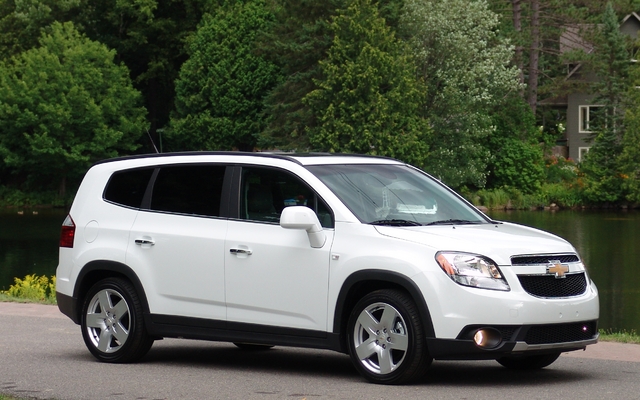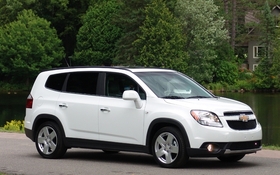2012 Chevrolet Orlando: Upgrades and corrections

| Strong points |
|
|---|---|
| Weak points |
|
In the early 80s, Chrysler broke new ground with the Dodge Caravan and Plymouth Voyager. Over time, these vehicles grew in size, in keeping with trends. Just a few years ago, Mazda unveiled its 5, a modern version of the minivan. Then Kia followed with the Rondo. Then Dodge with the Journey. And now Chevrolet wants in on the action with the Orlando. In terms of size, all of these vehicles fall somewhere between a classic minivan and a station wagon. The irony of it all is that the original 1984 Dodge Caravan was pretty much the same size as today’s "carefully designed" vehicles.
The Orlando was presented to the Canadian media last week. It was named after a Florida city to reflect a family lifestyle, but will not be sold in the U.S. as demand for this type of vehicle is weak south of the border. However, it has already made a name for itself in Europe, where it has been on sale for several months already. For those of you who remain sceptical about GM products, rest assured that the Orlando seems to have a good pedigree.
The Cruze’s Delta platform
To create the Orlando, the Cruze’s chassis was extended by three inches (75 mm) for a total difference in vehicle length of 2.7 inches (68 mm). The Orlando is also 6.3 inches (159 mm) taller. Its vast interior can accommodate up to seven people (compared to six in the Mazda5) – a fact that Chevrolet has made a point of emphasizing! But I’m forced to point out that certain versions of the Rondo and Journey can also seat seven. Conversely, the Orlando is not available as a five-seater. Chevrolet decided not to bother with sliding doors, like the Mazda5. The American automaker has its reasons, as does the Japanese one. What it boils down to is that the public is now divided on this point. There are those who like sliding doors and those who don’t. Period.
When the third row seats are empty and folded down (therefore not blocking rear visibility), there’s an acceptable amount of cargo space. It ranges from a pitiful 101 litres when all the seats are up to 1594 litres when both rows of seats are folded down. This is quite a bit less than the Dodge Journey and Kia Rondo, but a cut above the Mazda5 – another fact they were eager to point out at the launch! Below the carpet is a handy storage container, while the spare tire is tucked under the vehicle, like a real truck!
The dashboard is decidedly modern and the different controls are easy to find and read. I was happy to find a storage compartment behind the radio controls. But the hinges seemed a little flimsy. Most of the plastics are of good quality, despite their hardness. The cloth-covered seats seemed hard at first, but after a few kilometres I had already gotten used to them.
Just one engine for Canadians
Although Europeans have several engines to choose from, Canadians are only offered a 2.4-litre four-cylinder engine that produces 174 horsepower at 6,700 rpm and 171 lbs-ft of torque at 4,900 rpm. However, you do get a choice of transmissions, either a six-speed manual or six-speed automatic. Canadian journalists weren’t given the chance to drive the manual, as they aren’t in production yet.
Now, there’s one thing you should know right away: the engine doesn’t quite cut it, especially when all seven seats are taken. But it’s neither better nor worse than the four-cylinder engines found in its Mazda, Kia or Dodge rivals. The latter two, however, are also available with a V6. Only the front wheels are powered and AWD is not available, not even on option. During the test drive, we were unable to go from 0-100 km/h in less than 11.5 seconds (manual timing on public roads). This was underwhelming, especially since there were just two adults on board. According to General Motors, the automatic version’s fuel comsumption is 10.6 litres/100 km in the city and 6.9 litres/100km on the highway. We weren’t able to verify these claims during the test drive.
Truth be told, the automatic gearbox didn’t impress us either. Yet, it is well spaced and keeps the engine at just 2,000 rpm at 100 km/hr, which is about average for a four-cylinder. That said, the transmission was often hesitant to shift in either direction. Plus, during kick-down, you could tell that it was going down by at least two gears, a sign that the engine is not powerful enough for a vehicle that weighs 1,590 kg. It’s worth noting that the Orlando can tow up to 454 kg (1,000 lbs).
The LTZ: more money, more honey!
The Orlando is offered in four trim levels: the LS, 1LT, 2LT and LTZ. Obviously, the level of luxury increases with each, but the LTZ is equipped with 18-inch wheels and features some special settings for improved road handling. The first Orlando I tested was an LT1 on 16-inch wheels. My impressions of it may have been influenced by particularly high winds, but the steering seemed a little vague in the middle and the suspension was quite soft. My second test vehicle was the LTZ equipped with P235/45R18 tires. Its rear suspension is calibrated for sportier driving, as is the power steering. Although it’s not completely different, this Orlando is much more interesting than the other versions.
The LS, which GM says should only account for about 10% of sales, starts at $19,995. Next in line is the 1LT, which at $22,295 will probably be the most popular of the bunch. The 2LT retail price is $24,895 while the LTZ costs $29,735 and expects to only attract about 5% of buyers.
Predicting a newly unveiled vehicle’s success is always tough. The Orlando certainly has good things going for it (pleasant style, comfortable interior and versatile usage), but my concern is that its lacklustre engine could be its downfall. Plus there’s the fact that Kia is about to bring out an all-new Rondo with all the fixings. Fortunately for Chevrolet, the Mazda5’s latest upgrades are just partial and timid!











